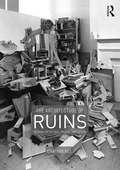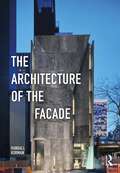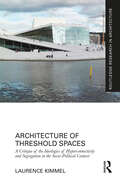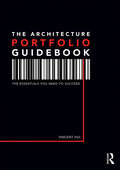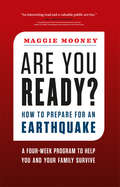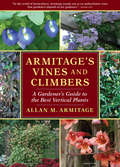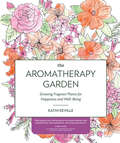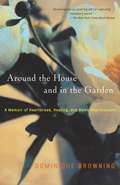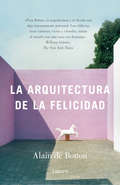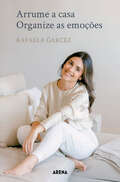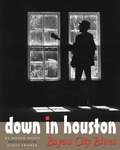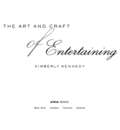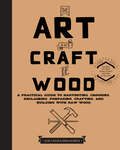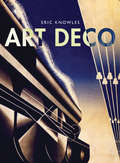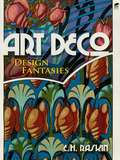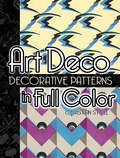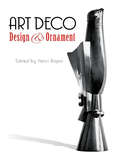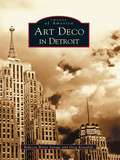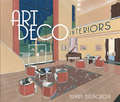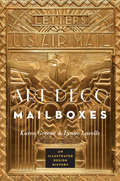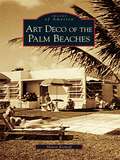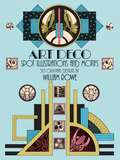- Table View
- List View
The Architecture of Ruins: Designs on the Past, Present and Future
by Jonathan HillThe Architecture of Ruins: Designs on the Past, Present and Future identifies an alternative and significant history of architecture from the sixteenth century to the twenty-first century, in which a building is designed, occupied and imagined as a ruin. This design practice conceives a monument and a ruin as creative, interdependent and simultaneous themes within a single building dialectic, addressing temporal and environmental questions in poetic, psychological and practical terms, and stimulating questions of personal and national identity, nature and culture, weather and climate, permanence and impermanence and life and death. Conceiving a building as a dialogue between a monument and a ruin intensifies the already blurred relations between the unfinished and the ruined and envisages the past, the present and the future in a single architecture. Structured around a collection of biographies, this book conceives a monument and a ruin as metaphors for a life and means to negotiate between a self and a society. Emphasising the interconnections between designers and the particular ways in which later architects learned from earlier ones, the chapters investigate an evolving, interdisciplinary design practice to show the relevance of historical understanding to design. Like a history, a design is a reinterpretation of the past that is meaningful to the present. Equally, a design is equivalent to a fiction, convincing users to suspend disbelief. We expect a history or a novel to be written in words, but they can also be delineated in drawing, cast in concrete or seeded in soil. The architect is a ‘physical novelist’ as well as a ‘physical historian’. Like building sites, ruins are full of potential. In revealing not only what is lost, but also what is incomplete, a ruin suggests the future as well as the past. As a stimulus to the imagination, a ruin’s incomplete and broken forms expand architecture’s allegorical and metaphorical capacity, indicating that a building can remain unfinished, literally and in the imagination, focusing attention on the creativity of users as well as architects. Emphasising the symbiotic relations between nature and culture, a building designed, occupied and imagined as a ruin acknowledges the coproduction of multiple authors, whether human, non-human or atmospheric, and is an appropriate model for architecture in an era of increasing climate change.
The Architecture of the Facade
by Randall KormanThe Architecture of the Facade provides a comprehensive study of the facade as both a physical and cultural artifact, highlighting its significance as a critical component of the civic realm and arguing for the restoration of the art of the facade as both a subject of study within academia and an aspiration within the profession at large. As the principal surface of mediation, contextualization, and representation, the facade carries the lion’s share of responsibility for containing the internal environment and confronting the outer world. And yet, in recent decades, the very question of what exactly a facade is has been raised by the dramatic changes in building technology, advances of parametric design, and the ubiquity of autonomous buildings. The Architecture of the Facade addresses these and other related issues. The book is organized into 12 chapters, with each chapter focusing on a particular aspect of the phenomenon of the facade such as those of wall, the frame, transparency, and the role of the facade in civic space. Korman also discusses proportional systems, the language of composition, the role of precedent, the importance of context, and much more. Over 350 photos and diagrams provide readers with a variety of examples of artful facades throughout history. Online teaching resources that accompany this book include a course syllabus, a glossary, and a Pinterest tack board of facades. This book will be of great interest to students in architecture studios as well as instructors and professional architects interested in facade design.
Architecture of Threshold Spaces: A Critique of the Ideologies of Hyperconnectivity and Segregation in the Socio-Political Context (Routledge Research in Architecture)
by Laurence KimmelThis book explores the relationship between architecture and philosophy through a discussion on threshold spaces linking public space with publicly accessible buildings. It explores the connection between exterior and interior and how this creates and affects interactions between people and the social dynamics of the city. Building on an existing body of literature, the book engages with critical philosophy and discusses how it can be applied to architecture. In a similar vein to Walter Benjamin’s descriptions of the Parisian Arcades in the nineteenth century, the book identifies the conditions under which thresholds reveal and impact social life. It utilises a wide range of illustrated international case studies from architects in Japan, Norway, Finland, France, Portugal, Italy, the USA, Australia, Mexico, and Brazil. Within the examples, thresholds become enhancers of social interactions and highlight broader socio-political contexts in public and private space. Architecture of Threshold Spaces is an enlightening contribution to knowledge on contemporary architecture, politics and philosophy for students, academics, and architects.
The Architecture Portfolio Guidebook: The Essentials You Need to Succeed
by Vincent HuiThe Architecture Portfolio Guidebook shows you how to make portfolios for both academic and professional needs to provide reviewers exactly what they are looking for. In school, architecture curricula nurture the knowledge and skills to develop design work to varying levels of presentation. In the profession, those skills are further developed and applied in the creation of the built environment. In both contexts, a portfolio is a core component for admission and advancement. This book provides key strategies to: • develop an understanding of the unique needs of professional and academic organizations; • identify applicants’ key differentiators; • highlight how applicants present themselves in their portfolios to address institutional needs; • create successful reinforcing documentation; • communicate using portfolios. Rather than proposing generic solutions, this book details the successful practices for portfolio creation by addressing portfolio creation academically and professionally. Supporting insights and examples from leading academics and architects from around the world reinforce the themes presented in this guidebook. An ideal read for students and professionals of architecture, landscape architecture, interior design, and urban design, looking to advance their studies and careers.
Architekturpsychologie Perspektiven: Band 2 Diskurs und Vermittlung
by Alexandra AbelIn der gebauten und vom Menschen beeinflussten Umwelt manifestiert sich unser Leben: Lebenshaltung, Lebensformen, Lebensentwurf. Indem man Architektur neu denkt, hat man daher das Potential, die derzeitige Form unseres Lebens zu überdenken. Ein solches Neu, Anders braucht eine Sensibilisierung für die Relevanz der gebauten Umwelt, für die Werte und Zielgrößen, die hinter einer bestimmten Gestaltung stehen und braucht einen gesamtgesellschaftlichen Diskurs zu der zentralen Frage: Wie wollen wir leben? Wie dürfen wir leben? Vor dem Hintergrund ökologischer und ökonomischer Fairness: Welche Lebensformen sind kompatibel mit einer möglichst hohen Lebensqualität für uns alle, als Teil eines Ökosystems, mit dem unser Wohlbefinden unauflöslich verbunden ist. In diesem Band kommen namhafte Expertinnen aus Österreich, der Schweiz und Deutschland aus den Disziplinen der Architektur, der Psychologie, der Kunst und Kunstdidaktik zu Wort, die sich zu der Relevanz und zu den Voraussetzungen einer solchen Debatte äußern.
Architekturpsychologie Perspektiven: Band 3 Entwurf und Prozess
by Martina GuhlWie findet die Begegnung von Psychologie und Architektur während des Entwurfs- und Planungsprozesses statt? In welchem Planungsabschnitt wird architekturpsychologisches Wissen relevant und einsetzbar? Welche Erkenntnisse liefert die urbane Architekturpsychologie für den städtebaulichen Diskurs? In diesem Buch bringen renommierte Expert*innen aus Deutschland, der Niederlande und der Schweiz aus den Disziplinen Architektur, Psychologie, Städtebau, Farbgestaltung und Kommunikationspsychologie ihr Pionierwissen ein.
Are You Ready?
by Maggie MooneyAs earthquakes have struck around the world with alarming frequency, millions have realized they are unprepared for similar catastrophes close to home. Online disaster plans and older books-heavy with seismic science and a survivalist focus-leave the average reader overwhelmed with details and anxiety. How much water will I need? What if I'm driving? How do I protect my six-year-old? The questions go on-and in this book Maggie Mooney answers them. Her four-week readiness program includes straightforward instructions, forms, and checklists. Mooney explains what to expect during a quake, and what to do when the shaking stops. She also addresses both aftershocks and tsunamis.Use this guide and the checklists inside to get ready:Find your safe spots at home, at work, at school, and outdoors.Develop your emergency communication plan.Shake-proof your home.Assemble emergency supplies. By following the steps in the four-week readiness program described here you can avoid injury and ensure you have the food, water and other essentials you need to be prepared rather than scared.
Armitage's Vines and Climbers: A Gardener's Guide to the Best Vertical Plants
by Allan M. Armitage“Climbing plants are hugely underrated—this book with its lively expression of deep knowledge should encourage everyone to grow more of them.” —Noël Kingsbury Climbing plants constitute a huge, and largely untapped, resource for today’s gardeners. Because their habit of growth is primarily vertical, they can be used for utilitarian as well as ornamental purposes like providing privacy, or screening eyesores. In this comprehensive reference, renowned horticulturist Allan Armitage selects and profiles the most useful and attractive climbing plants for a wide range of sites and conditions, from well-known favourites like clematis, morning glories, and wisteria to more unusual plants like Dutchman’s pipe, passion flowers, and the tropical mandevillas. Each profile includes a general description (enlivened by Armitage’s trademark wry humour) along with the plant’s hardiness, plant family, best method of propagation, method of climbing, and etymology of botanical and common names.“Climbing plants are hugely underrated—this book with its lively expression of deep knowledge should encourage everyone to grow more of them.” —Noël Kingsbury
The Aromatherapy Garden: Growing Fragrant Plants for Happiness and Well-Being
by Kathi Keville“Kathi guides you to all the joys of an aromatic garden with wonderful tips, fascinating facts, and sumptuous photos.” —Mandy Aftel, acclaimed natural perfumer and author of Essence and Alchemy and FragrantThe Aromatherapy Garden explains how fragrant plants can be as therapeutic as they are intoxicating, and how easy it is to add this captivating element to gardens large and small. It reveals the scents, secrets, and science behind fragrant plants, and how to optimize the full benefits of fragrance. Hone your powers of concentration with lemon verbena. Beat the blues with wintersweet. And use rose geranium to relieve anxiety and stress. Revealed here are the scents, secrets, and science behind plant aromatherapy, and how to optimize its full benefits. Detailed plant profiles will help you create a beautiful source of restorative aromas, oils, sachets, teas, and more. The nose knows—and with Keville’s expertise, now you too can create your own sanctuary of health and happiness
Around the House and in the Garden: A Memoir of Heartbreak, Healing, and Home Improvement
by Dominique BrowningWhen divorce tore Browning's home and heart apart, she began seeing with a new perspective. This is her therapeutic journey: she had taken care of the garden, now it would care for her.
Around the House and In the Garden
by Dominique BrowningFor six years, House & Garden editor-in-chief Dominique Browning has written a monthly column that weaves together personal stories and tips about home decorating, gardening, and raising children with universal themes of domestic life. In Around the House and in the Garden, Browning adapts and expands these well-loved pieces, adding dozens of new essays, to create an insightful and moving narrative about the solace and sense of self that can be found through tending one's home. From bedrooms and bathrooms to gardens and trees, from the importance of a couch in the kitchen to the spiritual role of a grand piano, Around the House and in the Garden reveals the intimate relationship between home and self. Browning illustrates the ways her domestic needs, instincts, and arrangements have reflected major changes in her family life. Considering her own divorce, she focuses on how grief inhabits a room: "When I was divorced my sense of home fell apart. And so, too, did my house." Eventually, attention to her home helped to mend her heart, and the attention to her heart helped her to tend her home. Brimming with warmth, knowledge, and the useful decorating and gardening tips that have made House & Garden a favorite for one hundred years, Around the House and in the Garden is a book for anyone who has ever felt the need to reinvent a life or a space, who has ever fallen in love with the idea of home -- the place where we reinvent ourselves, "the place where we have the final word about what goes where,...what feels comfortable, what is life-enhancing...a place that gives us strength to go out and embrace the world."
La arquitectura de la felicidad
by Alain de BottonAlternando ideas y anécdotas sabrosas, Alain de Botton nos ofrece un libro que habla de arquitectura, pero habla sobre todo de lo que nos falta y a menudo nos sobra para llegar a la auténtica felicidad. Si es verdad que somos lo que comemos, también es cierto que somos lo que habitamos, y basta con entrar en una casa para saber no solo qué posee, sino qué esconde y qué desea su dueño. La felicidad depende de la idea que tenemos de nosotros mismos, de la capacidad de casar lo que es con lo que debería ser, y eso se refleja en los objetos que nos rodean. Así es desde tiempos inmemoriales, y Alain de Botton nos lleva de la mano para que revisemos bajo esta óptica un tanto insólita los edificios que han marcado la historia de la arquitectura, desde la Villa Rotonda de Palladio hasta las casas funcionales de Le Corbusier y los rascacielos de Jean Nouvel. Stendhal dijo que la belleza es una promesa de felicidad, y cada cual tiene una idea de belleza de acuerdo con la época y las circunstancias en que le ha tocado vivir. Por eso lo que fue hermoso un tiempo, ahora no puede reproducirse tal cual sin que nos parezca inadecuado. Cierta innovación se impone, pero hay elementos arquitectónicos que se repiten a lo largo de los siglos porque responden a las necesidades hondas de los humanos, y el camino de la felicidad se apoya en ellos: en la simetría, por ejemplo, o en las curvas de ciertos objetos. Donde esté la disposición adecuada de líneas y trazos, estará nuestro hábitat ideal, ese lugar al que nos gusta volver porque ahí reencontramos lo mejor de nosotros mismos. Reseña:«Para Botton, la arquitectura y el diseño son algo intensamente personal. Los edificios tienen carácter, vicios y virtudes, miran al mundo con una cara casi humana.»William Grietes, The New York Times «De Botton tiene una maravillosa habilidad para abordar temas de peso desde puntos de vista amenos y excéntricos.»The Seattle Times «Un libro elegante e [...] inusual, lleno de grandes ideas. [...] Rara vez ha habido un matrimonio más delicado de palabras e imágenes.»The New York Sun «Con originalidad, brío e ingenio, De Botton explica cómo encontramos reflejos de nuestros propios valores en los edificios que construimos.»San Francisco Chronicle «De Botton mantiene la arquitectura a una escala humana.»Los Angeles Times «Alain de Botton ha devuelto a la filosofía su propósito más importante: ayudarnos a vivir mejor».Christina Hardyment, The Independent
Arrume a casa Organize as emoções
by Rafaela GarcezUm livro que nos ajuda a encontrar o essencial na nossa vida, seja nos objetos, seja nas emoções, através da organização. Este livro tem como objetivo ajudar o leitor a encontrar o seu essencial. Seja nos objetos que tem em casa, alguns dos quais guarda há anos apesar de já não servirem para nada, seja dentro de si. Para Rafaela Garcez, consultora de organização, o que guardamos e mantemos em casa, e forma como o fazemos, está relacionada com a organização das emoções de cada um. Desbloqueando uma casa cheia de tralha, abre-se espaço mental e emocional para o novo, o futuro brilhante e cheio de possibilidades. Ao ajudar-nos a encontrar o nosso essencial no espaço que habitamos, encontramos o essencial dentro de nós. E a partir daí podemos aprender a ser mais livres e leves. Em "Arrume a casa, organize as emoções" a autora apresenta soluções, passo a passo, para todas as áreas da vida: casa, carro, carteira, computador.Sim, ela até ensina a fazer limpeza e organização digital.
Art Against Dictatorship: Making and Exporting Arpilleras Under Pinochet
by Jacqueline AdamsArt can be a powerful avenue of resistance to oppressive governments. During the dictatorship of Augusto Pinochet in Chile, some of the country's least powerful citizens-impoverished women living in Santiago's shantytowns-spotlighted the government's failings and use of violence by creating and selling arpilleras, appliquéd pictures in cloth that portrayed the unemployment, poverty, and repression that they endured, their work to make ends meet, and their varied forms of protest. Smuggled out of Chile by human rights organizations, the arpilleras raised international awareness of the Pinochet regime's abuses while providing income for the arpillera makers and creating a network of solidarity between the people of Chile and sympathizers throughout the world. Using the Chilean arpilleras as a case study, this book explores how dissident art can be produced under dictatorship, when freedom of expression is absent and repression rife, and the consequences of its production for the resistance and for the artists. Taking a sociological approach based on interviews, participant observation, archival research, and analysis of a visual database, Jacqueline Adams examines the emergence of the arpilleras and then traces their journey from the workshops and homes in which they were made, to the human rights organizations that exported them, and on to sellers and buyers abroad, as well as in Chile. She then presents the perspectives of the arpillera makers and human rights organization staff, who discuss how the arpilleras strengthened the resistance and empowered the women who made them.
The Art and Craft of Entertaining
by Kimberly KennedyWhere do I begin? That's the question we start with when thinking about throwing a party -- and for many of us, that's the question we end with, too. We may like the idea of entertaining friends and family in our home, but the details -- those how to's of planning the party, making the food, and playing hostess -- can quickly overwhelm us, prompting us to tuck away the idea, waiting for another, better time. But it doesn't have to be that way. With The Art and Craft of Entertaining, author Kimberly Kennedy provides all the information and inspiration you need to plan, organize, and carry out a successful no-stress event. Marry some of her ideas with your own, and you'll be on the way to developing your style, gaining confidence as a hostess and elsewhere in your life. Whether you're throwing a cocktail party, a baby shower, or an intimate dinner for two, The Art and Craft of Entertaining will take you there, step-by-step. Instructive and encouraging, this essential book lays the groundwork for entertaining with style, demonstrating how to craft a perfect invitation for any occasion, organize your supplies into versatile and efficient arsenals, and plan a satisfying meal without breaking your budget. The Art and Craft of Entertaining shows how to mix passion with planning so that you can throw the party of your dreams. Inspiration without intimidation. That's The Art and Craft of Entertaining.
The Art and Craft of Wood: A Practical Guide to Harvesting, Choosing, Reclaiming, Preparing, Crafting, and Building with Raw Wood
by Silas J. KylerThe Art and Craft of Wood shows you how to mill, stack, dry, and flatten a log into useable lumber and build a variety of household furnishings. Trees are all around us. They provide shade, beautify our neighborhoods, filter our water, and clean our air, but when they die, we often don't know what to do with them. Now you can learn the skills to reclaim those trees as lumber. Perfect for the woodworking hobbyist, The Art and Craft of Wood introduces readers to the basics of wood craft. The Art and Craft of Wood will inspire you to make something of your own through simple, step-by-step photos. As a reader, you will learn valuable skills, including:Where to find wood that you can reclaim for your own useHow to mill, stack, dry, and flatten your log into useable lumberCreate a variety of useful household furnishings in 7 step-by-step projects ranging in difficulty from novice to more complicatedWhat to do with leftover material, such as making firestarters and animal beddingAuthors Silas Kyler and David Hildreth are also the filmmakers behind the documentary Felled, a film about giving new life to urban trees; they have lived the process of refining wood. The Art and Craft of Wood is their guide to you!
Art Deco
by Eric KnowlesAlthough most associated with the 1920s and 30s, Art Deco began in France prior to World War I. During the interwar years the style evolved and was adopted by an international elite set as the perfect expression of modern opulence and elegance in an age that gave birth to jazz, the Charleston, speakeasies, glamorous Hollywood films and engineering marvels such as skyscrapers. At the height of its popularity the Art Deco influence was seen in a wide variety of remarkable and innovative applications from decorative arts such as jewelry, metalwork, ceramics, and glass to massive scale applications in architecture, interior design, fashion, public works projects and consumer goods from automobiles to telephones to jukeboxes. This unique book is a collection of the most beautiful examples of Art Deco style from personal statements in jewelry to skyscrapers that defined city skylines, and examines the social and cultural climates of the 1920s and 30s which were perfectly aligned with the optimism and elegance of Art Deco. It traces the seminal influences in its evolution including the Ballets Russes, Cubism and the Bauhaus and explains why Art Deco style continues to attract new collectors and enthusiasts who connect with this design styles' impeccable ability to convey opulence, elegance, and exclusivity.
Art Deco: Design Fantasies
by E. H. RaskinDerived from a rare French publication of the 1920s, Fantaisies Oceanographiques, these beguiling images pulse with the flowing grace of aquatic life. The 30 full-color plates feature 56 abstract and figurative patterns in authentic Art Deco style. Whether simply browsed for pleasure or as a source of ideas for design or decorative projects, these playful images of marine plants and animals offer a wealth of inspiration.
Art Deco: Decorative Patterns in Full Color
by Christian StollDerived from various avant-garde painting styles of the early twentieth century, the Art Deco movement comprised a mix of Cubism, abstraction, distortion, and simplification. Geometric shapes and vibrant colors were popular elements of this sophisticated style of ornamentation that found expression in architecture and the applied arts.This collection of sensuous, bold and exotic motifs, reprinted from a rare 1910 portfolio, contains a wealth of arresting Art Deco wallpaper patterns. 160 striking, royalty-free designs--a must-have collection for designers and craftworkers--depict a breathtaking array of florals, geometrics, and abstract designs, all stunning in their presentation and elegant in their simplicity.
Art Deco Design and Ornament
by Henri RapinA major design movement of the 1920s and 1930s, Art Deco drew its strength from architecture, modern art, primitivism, and industry. It gave us the Chrysler Building and Soviet post art -- and also gave us a legacy that continues to pulse with energy and excitement even today.In this rich collection of 349 images, the Art Deco style is evident in every draping vine, languid curve, bulging muscle, and geometric figure. It will leap out at you from friezes, plaques, sculpture, vases, doorways, tiles, furniture, arches, and more.It's a splendid book for anyone interested in the arts -- and for artists and craftsmen, a genuine wellspring of artistic ideas.
Art Deco in Detroit
by Rebecca Binno Savage Greg KowalskiSince the 1920s, Art Deco, or "The Modern Style," has delighted people with its innovative use of materials and designs that capture the spirit of optimism to create the style of the future. Although the Detroit metro area is primarily known as an industrial region, it boasts some of the finest examples of Art Deco in the country. Art Deco in Detroit explores the wide-ranging variety of these architectural marvels, from world-famous structures like the Fisher and Penobscot Buildings, to commercial buildings, theaters, homes, and churches. Through a panorama of photographs, authors Rebecca Binno Savage and Greg Kowalski take readers on a fascinating tour of this influential movement and its manifestations in and around Detroit. The grandeur evident in some of the major buildings reflects a time when artisans and architects collaborated to craft structures that transcend functionality-they endure as standing works of art.
Art Deco Interiors
by Henry DelacroixFirst published in Paris as Decoration Moderne dans l'Interieur, this rare 1935 portfolio of full-color plates reflects the influence of Art Deco modernism on architects and interior designers. Designs for every space include living rooms, dining rooms, bedrooms, bathrooms, offices, terraces, artists' studios, and other settings. Equally eye-catching are the lighting, chairs, tables, beds, bookcases, desks, accessories, and other furniture along with floor and wall treatments and additional elements of modernist interior design. Captions identify the creator of every design, and the book includes a translation of the original Introduction and a new Publisher's Note. This splendid collection of authentic, hard-to-find designs will provide a treasury of inspiration for architects, interior designers, and designers of furniture and accessories as well as collectors of authentic Art Deco material and students of design, architectural history, and popular culture.
Art Deco Mailboxes: An Illustrated Design History
by Lynne Lavelle Karen GreeneA great gift book for lovers of unsung urban decorative art and unique architectural details. Mailboxes and their chutes were once as essential to the operation of any major hotel, office, civic, or residential building as the front door. In time they developed a decorative role, in a range of styles and materials, and as American art deco architecture flourished in the 1920s and 1930s they became focal points in landmark buildings and public spaces: the GE Building, Grand Central Terminal, the Woolworth Building, 29 Broadway, the St. Regis Hotel, York & Sawyer's Salmon Tower, the Waldorf Astoria, and many more. While many mailboxes have been removed, forgotten, disused, or painted over (and occasionally repurposed), others are still in use, are polished daily, and hold a place of pride in lobbies throughout the country. A full-color photographic survey of beautiful early mailboxes, highlighting those of the grand art deco period, together with a brief history of the innovative mailbox-and-chute system patented in 1883 by James Cutler of Rochester, New York, Art Deco Mailboxes features dozens of the best examples of this beloved, dynamic design's realization in the mailboxes of New York City as well as Chicago, Philadelphia, Indianapolis, Cincinnati, and beyond.
Art Deco of the Palm Beaches
by Sharon KoskoffArt Deco design is a jazzy celebration of the Machine Age, mass production, geometry, and the straight line. In Palm Beach County, sleek themes are seen representing tropical, nautical, masculine, and stylized motifs that reflect speed and technology. Elements include eyebrows, flat roofs, porthole windows, rounded corners, columns, glass blocks, bandings, multiples of three, and Zig-Zag steps. Palm Beach County has dozens of Art Deco treasures built throughout the 1920s, 1930s, and 1940s, which are located in the downtowns of Delray Beach up through West Palm Beach. Art Deco architecture found in Palm Beach County is spread out rather than concentrated in one location. These buildings are significant to the history of South Florida because they represent some of the earliest structures ever built in the area. These remarkable gems are in danger of being demolished due to the ever-increasing amount of development throughout the county.
Art Deco Spot Illustrations and Motifs: 513 Original Designs (Dover Pictorial Archive)
by William RoweThe sleek, exciting geometric motifs seen everywhere in today's decorative arts reflect the continuing Art Deco revival. Textiles, wallpaper, upholstery, and graphics abound with the dynamic, distinctive patterns associated with this influential and popular style.Now artists, designers, and craftspeople can have a treasury of original Art deco compositions at their fingertips -- ready for use in any graphic project. This volume includes over 500 crisp black-and-white spot illustrations and motifs combining stylized birds, insects, and floral elements with circles, squares, ovals, triangles, and other abstract forms. Best of all, they're copyright-free . . . no prior permission or fee is required for use. Remarkably inventive and versatile, William Rowe's masterful Art Deco renderings are perfect for highlighting advertisements, greeting cards, menus, catalogs and invitations, or for adding graphic vitality to fabric designs, stationery, bookplates, and a host of other arts and crafts undertakings. You'll find Art Deco Spot Illustrations and Motifs ideal for your needs whether your project calls for an entire illustration or just a single motif. Designers, illustrators, and craft enthusiasts will want to keep this time-saving, money-saving collection on hand as an inexhaustible source of inspiration with fresh Art Deco flavor.
